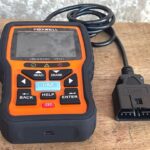Spoofing OBD2 data involves simulating or manipulating the data transmitted by a vehicle’s onboard diagnostic system. This can be done for various reasons, such as testing aftermarket devices, diagnosing vehicle problems, or even bypassing emissions tests. However, it’s crucial to understand the ethical and legal implications before attempting to spoof OBD2 data. Modifying emissions data is illegal in most jurisdictions. This article explores methods and considerations for OBD2 data spoofing.
Understanding OBD2 Data
OBD2 (On-Board Diagnostics II) is a standardized system that allows external devices to access vehicle diagnostic information. It uses a variety of communication protocols, including CAN (Controller Area Network), to transmit data about engine performance, emissions, and other systems. To spoof OBD2 data, you need to understand these protocols and the specific data parameters your vehicle uses.
Methods for Spoofing OBD2 Data
Several methods can be used to spoof OBD2 data, each with its own level of complexity:
1. Using an OBD2 Simulator
OBD2 simulators are devices designed to mimic the behavior of a vehicle’s ECU (Engine Control Unit). They can be programmed to send pre-defined data streams, allowing you to simulate various driving conditions and fault codes. These simulators are commonly used for testing diagnostic equipment and training technicians.
2. Modifying an Existing OBD2 Device
With sufficient technical knowledge, it’s possible to modify an existing OBD2 device, such as a scan tool or code reader, to transmit custom data. This typically involves reprogramming the device’s firmware or intercepting and modifying the data stream.
3. Building a Custom OBD2 Spoofer with Arduino
For advanced users, building a custom OBD2 spoofer using an Arduino microcontroller is an option. This requires a deep understanding of OBD2 protocols, CAN communication, and programming. An Arduino, combined with a CAN bus shield, can be programmed to transmit specific data packets to simulate desired OBD2 parameters. Choosing the correct CAN bus shield that supports the vehicle’s specific CAN protocol is critical.
Challenges and Considerations
Spoofing OBD2 data is not without its challenges:
- Protocol Complexity: Understanding and implementing the various OBD2 protocols can be complex.
- Vehicle Specific Data: Different vehicles use different data parameters and communication frequencies.
- Real-Time Requirements: Spoofing data often requires precise timing to avoid detection by the vehicle’s systems.
Legal and Ethical Concerns
Spoofing OBD2 data for illegal purposes, such as tampering with emissions readings, is strictly prohibited and carries severe penalties. It’s crucial to use this knowledge responsibly and ethically, primarily for educational or diagnostic purposes. Always consult local regulations before attempting any modifications to your vehicle’s OBD2 system.
Conclusion
Spoofing OBD2 data requires technical expertise and a thorough understanding of the underlying protocols. While it offers valuable opportunities for testing and diagnostics, it’s essential to proceed with caution and adhere to ethical and legal guidelines. Misusing this technique can have serious consequences. If unsure about any aspect of OBD2 data manipulation, consult a qualified automotive professional.


